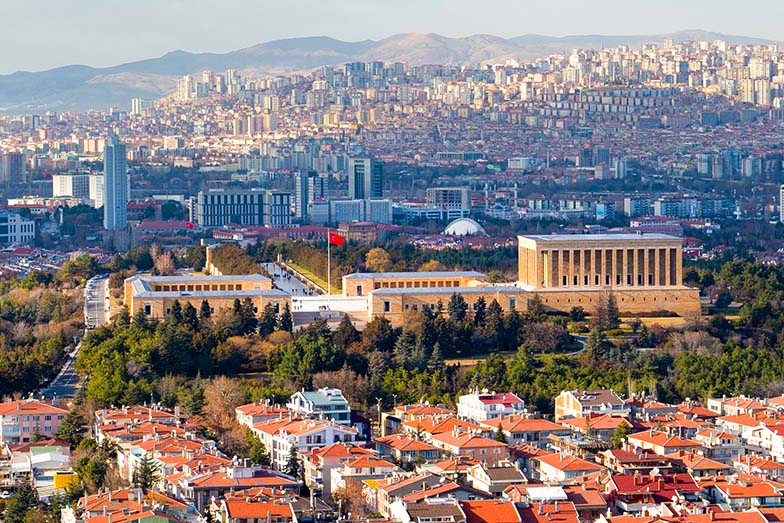History of Anıtkabir

From Rasattepe to Anıttepe
Anıttepe, now called Anıtkabir in honor of the mausoleum complex, was once known as Rasattepe, reflecting its history as an observation station. The site had been occupied by the Phrygian civilization in the 12th century BCE and Phrygian burial structures had been observed; following the determination of Rasattepe as the ideal location for Atatürk’s mausoleum, archaeological excavations started, in order to retrieve artifacts from the site. These items are now exhibited at the Museum of Anatolian Civilizations in Ankara.
October 9, 1944: A solemn groundbreaking ceremony
Following the expropriation efforts, a mausoleum befitting Mustafa Kemal Atatürk could be erected and, on October 9, 1944, a remarkable groundbreaking ceremony took place. The earth level and the retaining wall construction on Lion Road required an entire year, with the initial segment finalized in 1944-45.
Construction of the mausoleum, auxiliary buildings and ceremonial square
The construction of the mausoleum, the auxiliary buildings and the ceremonial square commenced in September 1945 and were completed approximately five years later, in 1950. The third phase of Anıtkabir’s construction involved the stone paving of the roads that lead to the monument, the lion’s path, the ceremonial square, and the mausoleum; as well as building the grand steps, replacing the sarcophagus stone, and installing the plumbing works. The last phase involved adding ornamentations and other final touches, with the completion of Atatürk’s final resting place scheduled for September 1, 1953.
The sections of Anıtkabir

Anıtkabir is a stellar architectural example of the period. The structure features two main sections, the Memorial Block and the Peace Park, covering a total area of 750,000 square meters.
Barış Park
In the Barış (Peace) Park, established in honor of Atatürk’s commitment to peace, saplings from various foreign nations and different regions of Türkiye were planted. Currently, the park contains 48,500 distinct ornamental trees, shrubs and plants, including trees and saplings sourced from Afghanistan, Austria, Belgium, Canada, China, Cyprus, Denmark, Egypt, England, Finland, France, Germany, Greece, India, Iraq, Israel, Italy, Japan, Norway, Portugal, Spain, Sweden, the United States and Yugoslavia.
Memorial Block
The Memorial Block (Anıt Bloku) of Anıtkabir includes the Lion Road (Aslanlı Yol), the Ceremonial Plaza (Tören Meydanı) and the Mausoleum.
Some specific details in the complex include the following.
A relief work by Zühtü Müridoğlu, accompanied by significant words attributed to Atatürk, is in the Independence Tower (İstiklal Kulesi).
The Freedom Tower (Hürriyet Kulesi) also features a relief by Zühtü Müridoğlu, accompanied by an Atatürk quote on freedom.
The Women Sculpture Group (Kadın Heykel Grubu) created by sculptor Hüseyin Özkan is meant to embody the women of Türkiye.
The Male Sculpture Group (Erkek Heykel Grubu), also by Hüseyin Özkan, depicts Turkish soldiers, youths and peasants.
Twenty-four statues of seated lions, symbolizing power and steadfastness, flank the 262-meter-long Lion Road (Aslanlı Yol).
The Ceremonial Plaza, which can hold 15,000 people, is decorated with intricate patterns mimicking those of Turkish rugs and carpets.
The Mehmetçik Tower houses Zühtü Müridoğlu’s portrayals of the Mehmetçik (Turkish Soldier); the Atatürk and Revolution Library (Atatürk ve Devrim Kütüphanesi) is between the Mehmetçik and Victory towers.
The Tomb of İsmet İnönü
This is the symbolic sarcophagus of İsmet İnönü. İnönü was Atatürk’s closest comrade-in-arms and served as the second President of Türkiye until 1950. İnönü was interred in Anıtkabir on December 28, 1973, following a decree from the Council of Ministers. His burial chamber is on the lower floor; the sarcophagus is between the Peace (Barış) and Victory (Zafer) Towers, set in the center of a gallery with open-sided columns.
Anıtkabir Atatürk Museum

The Anıtkabir Atatürk Museum opened to the public on June 21, 1960. It is accessible from the Misak-ı Milli Tower on the right when facing the Memorial Block (Anıt Bloğu) from the Ceremony Area in Anıtkabir. In 2001, a project prepared by Anıtkabir Command led to a decision to add approximately 3,000 square meters of columned space to the museum beneath the Hall of Honor (Şeref Salonu) in the Mausoleum. Now featuring 5,200 square meters of exhibition space, the museum reopened with a state ceremony on August 26, 2002. At that time, the museum was renamed the Atatürk and War of Independence Museum (Atatürk ve Kurtuluş Savaşı Müzesi).
The initial section of the museum is divided into four parts, with displays of Atatürk’s personal belongings, gifts from foreign dignitaries, and items contributed by his spiritual children: Afet İnan, Rukiye Erkin, and Sabiha Gökçen, who was Türkiye’s first woman pilot. The second section contains oil paintings depicting the Gallipoli War, the Battle of Sakarya and the Great Offensive, showing the challenges faced on the journey to establishing the Republic of Türkiye. The third section includes Atatürk’s burial chamber, as well as galleries depicting the National Struggle and revolutions, with these events from 1919 to 1938 described in Turkish and English. The final section houses 3,123 books from Atatürk’s library. The Atatürk Special Library (Atatürk Özel Kitaplığı) uses computers to present visitors with insights into Atatürk’s life, the development of Anıtkabir and the ceremonies conducted at the site, along with a collection of documents and photographs.
Where is Anıtkabir?

Anıtkabir is in the Çankaya district of Ankara. Atatürk’s eternal resting place is on the hill in Çankaya, in an area formerly known as Rasattepe and now called Anıttepe.
How many visitors come to Anıtkabir?
Thousands of people visit Anıtkabir daily, with particularly high visitor numbers on special days and historical occasions. A notable milestone was achieved on the 100th anniversary of the Republic, with 1,182,425 visitors to the site.
Information on visiting Anıtkabir
The visiting hours for Anıtkabir vary according to the time of year. Anıtkabir is open daily from 09:00 to 16:30 from February 1 to May 14; from 09:00 to 17:00 from May 15 to October 31; and from 09:00 to 16:00 from November 1 to January 31. Entry to the Anıtkabir complex, including the museum, is free.

